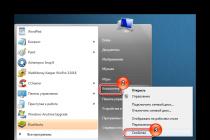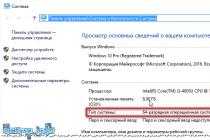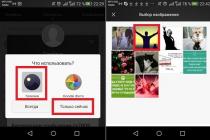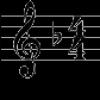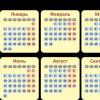This year, Nokia introduced a new line of smartphones using the Android platform, albeit in a radically redesigned form. We tested the largest representative of this new cohort - Nokia XL.
Specifications:
Communication: GSM/EDGE/UMTS (DualSIM)
Screen: IPS, 5 inches, 800 x 480
OS: Nokia X 1.0 (based on Android 4.1.2)
Processor: Qualcomm Snapdragon S4 (MSM8225), Adreno 203
RAM: 768 MB
User Memory: 4 GB, microSD expansion slot
Connectors: microUSB, audio output 3.5 mm
Wireless modules: Bluetooth 3.0, Wi-Fi
Camera: front - 2 MP, main - 5 MP
Dimensions: 141.4x77.7x10.9 mm
Weight: 190 g.
Battery: 2000 mAh
Extras: GPS, FM radio
Price: 1999 UAH
Despite the fact that the Nokia X series stands apart from other devices from the company, in terms of design it still uses the same combination of bright colors and classic shapes. As a result, the model is outwardly easy to confuse with more expensive Lumia smartphones. Well, the hero of our review is only good.


The manufacturer, apparently, did not set a goal to make Nokia XL thin or light. If we are to make a 5-inch smartphone, then there is no point in trifles. Calling the device thin by modern standards will not work, and its weight exceeds even some 6-inch devices.
On the other hand, how could it be otherwise, because you are buying a thing with the abbreviation XL in the title. Nevertheless, the device looks and feels solid and well-assembled in the hands.
Despite the large diagonal, the screen resolution is not very high - 800 x 480 pixels. In general, the picture is bright and contrasting, the viewing angles will not disappoint either, but there is moderate pixelation here. But not a high resolution screen has a positive effect on the autonomy of the gadget.


Special thanks to the manufacturer for supporting two SIM-cards. In Nokia smartphones, this is perceived as a pleasant innovation, while in the CIS countries the function is incredibly popular.
Both cards are connected at the same time. But when one of them receives a call, the second remains without communication until the conversation is over. Without support for 3G technology UMTS is also not done.
Nokia XL uses 2-core Qualcomm processor Snapdragon S4 (MSM8225) and 768 MB of RAM. In AnTuTu Benchmark, the device scored about 8000 points, which is not very much, but typical for a state employee. The interface seems to be well optimized, so there are no slowdowns in everyday tasks. But counting on dynamic 3D games, of course, is not worth it.



The operating system uses a modified version of Android 4.1.2, which the manufacturer calls Nokia X Platform. Interface changes compared to stock Android are so significant that, indeed, there is a feeling that we have a completely different platform.


Literally everything has been redesigned, from the icon design to the menu organization scheme itself. There are certain similarities with Windows phone- the same "tiles" on the main screen. Obviously, the company is trying to make it easy for a user who has tried Nokia X to switch to, for example, Lumia.


But the main advantage of the platform, perhaps, is that it is compatible with Android applications. True, not without reservations. So, the device does not have the usual Google services, like Play market. Therefore, applications are suggested to be installed from the Nokia store or other alternative “markets”.
It may be difficult for the user to find a specific game or a familiar mailing program for this smartphone. By the way, if you are looking for such software or service, we can recommend the Prosto.email solution (prostoemail.ru), which works directly in the browser. This is a popular mailing system, highly effective and, importantly, quite affordable. In general, unlike specialized software, the user will have all the basic software for Nokia XL. Of the preinstalled Nokia services, I would especially like to mention the Here navigation, which also works offline.
The resolution of the built-in camera is only 5 megapixels. However, to say that she is here for show would be unfair. Apparently, the camera copes with its task as well as possible, given the hardware used.
In general, making a good shot during daylight hours and in good weather is not a problem at all. For shooting at dusk and indoors, you can use the built-in flash, which, by the way, is not in the younger model - Nokia X.
The large dimensions of the body made it possible to install a fairly capacious 2000 mAh battery in Nokia XL. In combination with a low-resolution display and an economical processor, it provides good autonomy. In our case, this is about two days of active work.

Summary
Nokia XL is relative inexpensive smartphone with a nice design, dual SIM support and preinstalled Nokia services. First of all, it can be recommended to fans of the brand. For example, those who previously used conventional push-button telephones, but now “ripe” for something more functional. Nevertheless, there are many alternatives on Android, which sometimes offer more powerful hardware and familiar Google services for the same price - the same Play Market. True, Nokia XL is clearly more interesting in appearance - inexpensive Android smartphones rarely boast a bright design. The choice is yours.
Information about the make, model, and alternative names of a particular device, if any.
Design
Information about the dimensions and weight of the device, presented in different units of measurement. Used materials, suggested colors, certificates.
| Width Width information refers to the horizontal side of the device in its standard orientation during use. | 77.72 mm (millimeters) 7.77 cm (centimeters) 0.25ft 3.06in |
| Height Height information refers to the vertical side of the device in its standard orientation during use. | 141.35 mm (millimeters) 14.14 cm (centimeters) 0.46 ft 5.56in |
| Thickness Information about the thickness of the device in different units measurements. | 10.87 mm (millimeters) 1.09 cm (centimeters) 0.04ft 0.43in |
| Weight Information about the weight of the device in different units of measurement. | 190 g (grams) 0.42 lbs 6.7oz |
| Volume Approximate volume of the device, calculated from dimensions provided by the manufacturer. Refers to devices with the shape of a rectangular parallelepiped. | 119.41 cm³ (cubic centimeters) 7.25 in³ (cubic inches) |
| Colors Information about the colors in which this device is offered for sale. | Orange Green blue green Yellow Black White |
SIM card
The SIM card is used in mobile devices to store data that certifies the authenticity of mobile service subscribers.
Mobile networks
A mobile network is a radio system that allows multiple mobile devices to communicate with each other.
Mobile technologies and data rates
Communication between devices in mobile networks is carried out through technologies that provide different data transfer rates.
Operating system
The operating system is the system software that manages and coordinates the operation of the hardware components in the device.
SoC (System on a Chip)
System on a chip (SoC) includes all the most important hardware components of a mobile device in one chip.
| SoC (System on a Chip) System on a chip (SoC) integrates various hardware components such as processor, GPU, memory, peripherals, interfaces, etc., as well as the software necessary for their operation. | Qualcomm Snapdragon S4 Play MSM8225 |
| Technological process Information about the technological process by which the chip is made. The value in nanometers measures half the distance between the elements in the processor. | 45 nm (nanometers) |
| Processor (CPU) The main function of the processor (CPU) of a mobile device is the interpretation and execution of instructions contained in software applications. | ARM Cortex-A5 |
| Processor bit depth The bit depth (bits) of a processor is determined by the size (in bits) of registers, address buses, and data buses. 64-bit processors have higher performance than 32-bit processors, which, in turn, are more productive than 16-bit processors. | 32 bit |
| Instruction Set Architecture Instructions are commands by which the software sets/controls the operation of the processor. Information about the instruction set (ISA) that the processor can execute. | ARMv7 |
| Level 0 Cache (L0) Some processors have an L0 (level 0) cache that is faster to access than L1, L2, L3, etc. The advantage of having such a memory is not only higher performance, but also reduced power consumption. | 4 kB + 4 kB (kilobytes) |
| First level cache (L1) Cache memory is used by the processor to reduce access time to more frequently accessed data and instructions. L1 (level 1) cache is small and much faster than both system memory and other cache levels. If the processor does not find the requested data in L1, it continues to look for them in the L2 cache. With some processors, this search is performed simultaneously in L1 and L2. | 16 kB + 16 kB (kilobytes) |
| Second level cache (L2) L2 (level 2) cache is slower than L1, but in return it has a larger capacity, allowing more data to be cached. It, like L1, is much faster than system memory (RAM). If the processor does not find the requested data in L2, it continues to look for it in the L3 cache (if available) or RAM. | 1024 KB (kilobytes) 1 MB (megabytes) |
| Number of processor cores The processor core performs program instructions. There are processors with one, two or more cores. Having more cores increases performance by allowing many instructions to be executed in parallel. | 2 |
| Processor clock speed The clock speed of a processor describes its speed in terms of cycles per second. It is measured in megahertz (MHz) or gigahertz (GHz). | 1000 MHz (megahertz) |
| Graphics Processing Unit (GPU) Graphics Processing Unit (GPU) handles calculations for various 2D/3D graphic applications. V mobile devices it is used most often by games, consumer interface, video applications, etc. | Qualcomm Adreno 203 |
| Volume random access memory(RAM) Random access memory (RAM) is used by the operating system and all installed applications. Data stored in RAM is lost when the device is turned off or restarted. | 768 MB (megabytes) |
Built-in memory
Each mobile device has a built-in (non-removable) memory with a fixed amount.
Memory cards
Memory cards are used in mobile devices to increase the storage capacity for storing data.
Screen
The screen of a mobile device is characterized by its technology, resolution, pixel density, diagonal length, color depth, etc.
| Type/technology One of the main characteristics of the screen is the technology by which it is made and on which the image quality of information directly depends. | IPS |
| Diagonal For mobile devices, the screen size is expressed in terms of its diagonal length, measured in inches. | 5 in 127 mm (millimeters) 12.7 cm (centimeters) |
| Width Approximate Screen Width | 2.57in 65.34 mm (millimeters) 6.53 cm (centimeters) |
| Height Approximate Screen Height | 4.29in 108.9 mm (millimeters) 10.89 cm (centimeters) |
| Aspect Ratio The ratio of the dimensions of the long side of the screen to its short side | 1.667:1 5:3 |
| Permission Screen resolution indicates the number of pixels vertically and horizontally on the screen. Higher resolution means sharper image detail. | 480 x 800 pixels |
| Pixel Density Information about the number of pixels per centimeter or inch of the screen. Higher density allows information to be shown on the screen in clearer detail. | 187 ppi (pixels per inch) 73 ppcm (pixels per centimeter) |
| Color depth Screen color depth reflects the total number of bits used for the color components in a single pixel. Information about the maximum number colors that the screen can show. | 24 bit 16777216 flowers |
| Screen area Approximate percentage of screen space on the front of the device. | 64.98% (percentage) |
| Other characteristics Information about other functions and features of the screen. | capacitive Multitouch |
Sensors
Different sensors perform different quantitative measurements and convert physical indicators into signals that are recognized by the mobile device.
rear camera
The main camera of a mobile device is usually located on its rear panel and can be combined with one or more additional cameras.
| Sensor size Information about the size of the photosensor used in the device. Typically, cameras with a larger sensor and lower pixel density offer better image quality despite lower resolution. | 3.6 x 2.7 mm (millimeters) 0.18in |
| Pixel size Pixels are usually measured in microns. Larger pixels are capable of capturing more light and therefore provide better low-light shooting and a wider dynamic range than smaller pixels. On the other hand, smaller pixels allow higher resolution while maintaining the same sensor size. | 1.389 µm (micrometers) 0.001389 mm (millimeters) |
| crop factor The crop factor is the ratio between the size of a full-frame sensor (36 x 24mm, equivalent to a frame of standard 35mm film) and the size of the device's photosensor. The number shown is the ratio of the diagonals of the full frame sensor (43.3 mm) and the photo sensor of the specific device. | 9.61 |
| Svetlosila Luminosity (also known as f-stop, aperture, or f-number) is a measure of the aperture size of a lens that determines the amount of light that enters the sensor. The lower the f-number, the larger the aperture and the more light reaches the sensor. Usually, the number f is indicated, which corresponds to the maximum possible aperture of the aperture. | f/2.8 |
| Focal length Focal length indicates the distance in millimeters from the sensor to the optical center of the lens. The equivalent focal length (35mm) is the focal length of a mobile device camera that is equal to the focal length of a 35mm full frame sensor that would achieve the same angle of view. It is calculated by multiplying the actual focal length of the mobile device's camera by the crop factor of its sensor. The crop factor can be defined as the ratio between the 35mm diagonals of a full-frame sensor and a mobile device sensor. | 3.33 mm (millimeters) 32.02 mm (millimeters) *(35 mm / full frame) |
| Flash type The rear (rear) cameras of mobile devices mainly use LED flashes. They can be configured with one, two or more light sources and vary in shape. | LED |
| Image Resolution One of the main characteristics of cameras is resolution. It represents the number of horizontal and vertical pixels in an image. For convenience, smartphone manufacturers often list resolution in megapixels, giving an approximate number of pixels in millions. | 2592 x 1944 pixels 5.04 MP (megapixels) |
| Video resolution Information about the maximum video resolution that the camera can record. | 864 x 480 pixels 0.41 MP (megapixels) |
| Video recording speed (frame rate) Information about the maximum recording rate (frames per second, fps) supported by the camera at maximum resolution. Some of the most basic video recording speeds are 24 fps, 25 fps, 30 fps, 60 fps. | 30 fps (frames per second) |
| Specifications Information about additional software and hardware features of the rear (rear) camera. | digital zoom panoramic shooting Face recognition Adjusting the white balance ISO setting |
Front-camera
Smartphones have one or more front cameras of various designs - a pop-up camera, a PTZ camera, a cutout or hole in the display, a camera under the display.
Radio
The radio of the mobile device is a built-in FM receiver.
Location determination
Information about navigation and location technologies supported by the device.
WiFi
Wi-Fi is a technology that provides wireless communication for short distance data transmission between different devices.
Bluetooth
Bluetooth is a standard for secure wireless data transfer between different types of devices over short distances.
| Version There are several Bluetooth versions, with each subsequent one improving communication speed, coverage, making it easier to discover and connect devices. Information about the Bluetooth version of the device. | 3.0 |
| Specifications Bluetooth uses different profiles and protocols to provide more fast exchange data, power savings, improved device discovery, and more. Some of these profiles and protocols that the device supports are shown here. | A2DP (Advanced Audio Distribution Profile) AVRCP (Audio/Visual Remote Control Profile) DUN (Dial-Up Networking Profile) FTP (File Transfer Profile) GAVDP (Generic Audio/Video Distribution Profile) HFP (Hands Free Profile) HSP (Headset Profile) OPP (Object Push Profile) PAN (Personal Area Networking Profile) PBAP/PAB (Phone Book Access Profile) HS |
USB
USB (Universal Serial Bus) is an industry standard that allows different electronic devices to communicate.
Headphone jack
This is an audio connector, which is also called an audio jack. The most widely used standard in mobile devices is the 3.5mm headphone jack.
Connecting devices
Information about other important connection technologies supported by the device.
Browser
A web browser is a software application for accessing and viewing information on the Internet.
Video file formats/codecs
Mobile devices support various video file formats and codecs, which store and encode/decode digital video data, respectively.
Battery
Mobile device batteries differ from each other in their capacity and technology. They provide the electrical charge they need to function.
| Capacity The capacity of a battery indicates the maximum charge it can store, measured in milliamp-hours. | 2000 mAh (milliamp-hours) |
| A type The type of battery is determined by its structure and, more specifically, by the chemicals used. Exists different types batteries, with lithium-ion and lithium-ion polymer batteries most commonly used in mobile devices. | Li-Ion (Li-Ion) |
| Talk time 2G Talk time in 2G is the period of time during which the battery is completely discharged during a continuous conversation in a 2G network. | 16 h (hours) 960 min (minutes) 0.7 days |
| 2G standby time The 2G standby time is the amount of time it takes for the battery to fully discharge when the device is in stand-by mode and connected to a 2G network. | 720 h (hours) 43200 min (minutes) 30 days |
| 3G talk time Talk time in 3G is the period of time during which the battery is completely discharged during a continuous conversation in a 3G network. | 13 h (hours) 780 min (minutes) 0.5 days |
| 3G standby time The 3G standby time is the amount of time it takes for the battery to fully discharge when the device is in stand-by mode and connected to a 3G network. | 720 h (hours) 43200 min (minutes) 30 days |
| Specifications Information about some additional features of the device's battery. | Removable |
| Battery model: BN-02 |
Nokia XL is the company's alternative offering for fans of the Android operating system. An attempt by Nokia to take over another part of the smartphone market. Let's take a look at the Nokia XL user reviews, as well as the characteristics of experts, and try to determine based on them whether this company will be able to achieve what they want? What is good about this phone? How do those who have acquired and tested its capabilities speak of it?
About good
About Nokia XL reviews indicate that the phone is on this operating system works stably - does not hang. Convenient to use. It has clear interface and comfortable in the hand. When using, there are no slowdowns. All communications work perfectly. Signal reception and transmission is reliable both via telephone networks and Wi-Fi, Bluetooth. Has a good camera. The flash works great. The battery holds up well. Users also benefit from:
- big screen;
- decent power of the device;
- loud speaker;
- the ability to switch between SIM cards;
- front camera with Skype support.
About the bad
About Nokia XL, user reviews indicate that it does not sync with a PC. It is not possible to install applications on a memory card. operating room android system cut down. Few applications on the "Market". Heats up quickly and intensely. There are problems with opening the back cover.
About cost and operating system
XL is, one might say, the "big brother" X from Nokia. You can buy it on average for 7000 rubles. The device works on the basis of its own firmware, bringing the appearance of the interface closer to Windows Phone. This, of course, limits the possibilities and makes it impossible to access services from Google, including Play.
What's in the box?
The kit for the device includes:
- headset, unfortunately, without a call key;
- charger that connects to microUSB.
Nokia XL Dual, review: briefly about the main thing
The screen is made using TFT IPS technology and has a resolution of 480 x 800 pixels, or 187 dots per inch. The processor of the device is dual-core with a frequency of 1 GHz. RAM - 768 MB. The built-in memory of the smartphone is 4 GB. Dimensions - 41.4 x 77.7 x 10.9 mm. These Nokia XL characteristics say a lot, but do not allow us to appreciate this device.

Appearance
Allow you to explore the look of Nokia XL photos. The buyer is offered a wide variety of colors. It is possible to install a phone cover of a different color. The build quality of the phone can be called perfect. Given that it is collapsible, when you hold it in your hand, it is not felt. Thanks to the polycarbonate of which the body is made, the phone does not scratch, does not slip, pleasant and firm to the touch. Its front side is completely covered with glass. The five-inch display has an aspect ratio of 16:10. Directly above it is a peephole. There are also light and proximity sensors. Under the display, the manufacturer has placed touch keys.
At the bottom is a microUSB-connector. The top has a 3.5mm headset jack. The right end bears a polycarbonate volume rocker. Below it is a lock/on button.
In the middle of the rear panel is a camera eye, above which is a flash. There is a speaker in the lower back of the case.
An easy-to-remove cover hides the battery, dual-SIM slots and a microSD slot.

Ergonomics of the device
The ease of use of Nokia XL Dual SIM is ensured by its light weight - only 190 grams, well-thought-out button layout, rounded back cover. Despite its size, it fits comfortably in the hand. Its shape follows the shape of the palm. The rough body inspires confidence that the device will not slip out of your hand. The lock and volume keys fit comfortably under your fingers, which makes it possible to operate the device with one hand.
Screen
It is quite large and bright in this device. In general, pleasant, but still budget. Is different high quality performance, has the correct color reproduction and fairly wide viewing angles. I would like the pixel density to be higher, but this is quite enough so that the eyes do not get tired for a long time when working with the device.
The disadvantages include poor protection against glare. No matter how you turn the device, reflections cannot be avoided. The finger glides freely on the screen, which pleases with the fact that it does not get dirty much.
Interface
The most interesting thing about this device, of course, is its interface. In it (which may upset the admirers of this software) there is very little left of Android. The firmware was developed on the basis of an outdated version of this operating system. New interface is called Fastlane, since there is practically nothing left of the old one. We must pay tribute to the developers - it turned out to be very simple and understandable and prettier than "Google".
The icons located on the poles have a multi-colored background. The screen can be scrolled down like a web page, which is visual, convenient and pretty. At the top is a search bar, using which you can easily search the Internet and open applications.
Swipe opens the curtain from the bottom up, in which you can switch between SIM cards, Bluetooth, Wi-Fi, turn off the sound, etc. It’s bad that there is no flashlight icon here.
The only place that clearly indicates that this is still an "Android" is the settings menu. It is like all "Googlephones". The Fastlane interface, if desired, can be changed to another "launcher" - and the device will become more like an Android device. But it is not recommended to do this, since the installed one is adapted for this device and is much more convenient than the others.

There are no non-screen keys, which made it possible to give more space to the screen. There is only one touch key. A short press returns to the previous position, a long press takes you to the home screen (which, of course, is very convenient to use).
To say that the device flies means to lie, but the speed of its work is still very good. The device does not have long freezes.
Despite the fact that it is not tied to Google, use social networks, the device allows you to transfer photos. Although the device does not have the Play Market, all the usual applications can be found in the Nokia store.
The choice in it, of course, is not the same as in Google Play, but there are no various viral applications and garbage. And "Yandex.Store" provides almost everything you need for a not very demanding user. At the same time, the choice is better than that of Windows Phone.
Advanced users will certainly be disappointed. But they can solve all their problems by flashing the device.
Photo video

The advantages of all Nokias are their cameras. But you shouldn't rejoice too much, because this is still a state employee, and not a representative of the Lumiy line. That's why PureView isn't here.
The main camera is 5 megapixel. With its help during the day, you can produce quite good pictures. But already with artificial lighting, they leave much to be desired. The device has autofocus and flash. The flash is more for show, but the autofocus is quite good. Color rendition is clearly dull. The image is easily smeared, so you need to hold the smartphone firmly in your hands and do not take pictures on the go - nothing good will come of it.
Front-camera only good for what it is. But for those who do not need a high-quality image when communicating on Skype, it is quite suitable. But for a "selfie" on Instagram, it's better not to use it.
Wireless interfaces

Smartphone Nokia XL Dual SIM does not indulge in a variety of wireless technologies. Neither MIRACAST nor NFC smartphone do not support. Of course, like others, good wifi a gadget and, although outdated, but working stably without Bluetooth failures.
autonomy
The device can function for quite a long time without recharging. This makes possible a fairly capacious 2000 mAh battery, not powerful processor and low A day's worth of charge is enough even for the most active user.
Device in operation
Of course, it is not designed to play FullHD video. Not all 3D entertainment and heavy games will go with a bang, but everything else will be no problem.
Conversational speaker is good, which can not be said about the music. With a strong sound, noises are heard, so it is better to listen to songs with headphones.
Results from experts
pros:
- beauty of design;
- good build quality;
- excellent ergonomics;
- convenient and simple interface;
- two SIM cards;
- long battery life.
Minuses:
- no access to Google Play;
- insufficiently powerful processor for a wide monitor;
- low resolution;
- not very good front and rear cameras.

conclusions
About Nokia XL reviews indicate that this is a well-assembled device. Suitable as the first smartphone and those who are not very picky about this kind of devices, for which the size of the display, simplicity and clarity of the interface are important.
In general, having studied the reviews and characteristics of experts about Nokia XL Dual SIM, we can conclude that this device, despite its shortcomings (who doesn’t have them?), Has every chance of winning the love of a certain category of buyers and a part of the market for Nokia. We must give credit to this company - she tried. Than once again it did not disappoint its fans, providing a sufficiently high-quality and balanced device.
The company believed that Nokia smartphones with Android OS would not allow them to stand out from other manufacturers. As an alternative, the well-known Windows Phone platform was chosen. And although it has gained sufficient popularity in Lately, smartphones from other companies on the Android OS are sold much more often. Android smartphones are becoming more functional every year, while their price is decreasing. Given this, Nokia decided to create their own version of Android. The developers were faced with the task, on the one hand, to create a smartphone that will run Android applications, on the other hand, it was important that the device was not called an Android smartphone and there was no mention of Google. The operating system has changed beyond recognition. The company has put a lot of effort into making it look different from regular Android. The interface of a new operating system is a collection of elements from operating Windows systems Phone, Android and Asha. The home screen is very similar to the screen from the Windows Phone OS.
The first smartphone based on the new operating system, Nokia XL, was presented by the company on February 24, 2014 at the Mobile Congress in Barcelona. The positioning of Nokia's new smartphone is very simple - "bright smartphone for Android applications." The main audience of this device is young people who feel the need for a smartphone, but do not want to spend a lot of money on it. Also, enthusiasts and software developers, those who like to explore everything new, may be interested in the smartphone. Today we will take a closer look at the novelty and try to identify all the pros and cons of the smartphone.
Contents of delivery
The Nokia XL smartphone comes in a compact cardboard box, which is already familiar to other Nokia products. In the kit, in addition to the smartphone itself, you will find:
— Charger AC-20
— Battery Nokia BN 02 2000 mAh
- Nokia Stereo Headset WH-108
- Quick Guide
The equipment is rather poor, but it is due, first of all, to the low price of the smartphone.
Design
Nokia has always tried to be different in terms of design. The company's engineers often experimented with the appearance of their smartphones, but one of the most successful, according to users, was the design. Nokia Lumia. In Nokia XL, as well as in the Asha line, they tried to create a cheaper version of the case, similar in appearance to the Lumia line. However, the Nokia XL smartphone uses inexpensive plastic, and the case is disassembled.
Another feature that is typical only for Nokia smartphones is a wide variety of color solutions. If most companies try not to present many different body colors, Nokia, on the contrary, considers this a plus. Thanks to this, the user always has the opportunity to choose exactly the color that he likes.
Smartphone Nokia XL can not be called compact. It measures 77.72mm x 141.35mm x 10.87mm and weighs 190g. The smartphone feels quite wide, and the sharp corners make it a little uncomfortable in the hand. If you convey the feeling in words, the device can be described as a "heavy brick". However, Nokia XL is designed just for fans big smartphones, so the buyer, for sure, will be ready for such dimensions of the device.
As for ergonomics, everything is familiar here. On the right side of the smartphone is a paired volume rocker, just below the on/off button.

At the top end there is a 3.5 mm jack.

The microUSB connector is located on the bottom. The left side of the smartphone is completely empty. It doesn't have any buttons.

The back surface of the smartphone is quite simple. It has a speaker hole, a 5-megapixel camera lens and a flash, as well as the Nokia logo. On the front panel there is a front camera for video calls and a single button under the screen, which plays a dual role: a short press - a step back, a long press - return to the home screen. The solution is ambiguous. Some will like it, some won't. Matter of habit.

The build quality of the smartphone does not cause any complaints. A matte case is used, when pressed, it does not play and does not hold together. For a budget device, the quality of the materials from which the case is made is excellent.
Under the back cover is the battery, as well as two slots for microSIM cards and a slot for a microSD memory card.

Display
The smartphone uses a 5-inch screen. An IPS-matrix with a resolution of 800x480 pixels and a color depth of 24 bits is installed. In most situations, the picture looks good. However, considering the screen size, the resolution is not enough. Nevertheless, if you do not require something special from the device, the majority of users should like the screen. The brightness of the display is quite high, there is an automatic adjustment. In bright light, the image dims, but remains readable.


Display Nokia smartphone XL has good viewing angles, the image is not distorted when tilted.

I did not like the fact that the fonts do not have anti-aliasing, in most situations they do not look very good. In any Android smartphone from any other manufacturer, there is no such problem with fonts as on Nokia XL. The same situation is with the menu icons. They are not very well adapted to the screen resolution and to the operating system. I hope the company will fix this shortcoming in the next updates of the operating system. In the screen settings, you can specify the display of the clock in standby mode. This feature has been used in Nokia phones and smartphones for quite a long time and will be very useful if the user does not wear wrist watch. The Nokia XL smartphone also has a proximity sensor, during a call the screen is locked.
Technical features
The Nokia XL smartphone is built on a Qualcomm chipset and is referred to on the Nokia website as the Snapdragon S4 Play MSM8225. This is already a rather outdated type of chipset. Even the not new Nokia Lumia 520 uses the MSM8227 chipset, which is somewhat more productive. Nokia XL dual-core processor clocked at 1 GHz. The device uses the Adreno 203 graphics coprocessor, its performance is also quite low. Among the "budget" devices Nokia XL is not the most productive solution. The reason is the use of inexpensive components from Qualcomm, which are inferior to analogues from other manufacturers. However, if you do not intend to run resource-intensive 3D games and heavy applications on Nokia XL, the performance of the device will be enough for you.
Nokia XL has 4 GB of internal memory, as well as 768 MB of RAM. Unfortunately, all devices built on the platform from Qualcomm are more demanding on RAM than their counterparts on MediaTek. After downloading, about 326 MB of RAM is free. Android's memory management is good enough that apps get the right amount of memory and use as much memory as possible.
For data storage, 1.29 GB is allocated in the phone's memory, 1.17 GB is shown as a memory card, plus the user can install their own memory card up to 32 GB. The main disadvantage of the nokia XL operating system is that all applications are installed in the phone's memory, that is, the user is limited to exactly 1.29 GB in size and this cannot be avoided. Installing applications on a memory card is not yet supported. Perhaps this will be fixed in the next versions of the operating system.
In all other respects, the Nokia XL is a typical Android smartphone. There is the ability to transfer files via Bluetooth, there is Wi-Fi, there is USB mode Mass Storage when connected to a PC.
The Nokia XL smartphone supports two SIM cards, but there is only one radio module in the device, so only one SIM card can be active at a time. This is a cheaper version of the implementation of the presence of two SIM-cards, which is currently the most common on the market and in the devices of this price segment. The smartphone supports WCDMA networks: 900 MHz, 2100 MHz and GSM networks: 850 MHz, 900 MHz, 1800 MHz, 1900 MHz. In the settings, you can choose one card for SMS/MMS/calls, or specify them as standalone, that is, they work independently. The list of calls indicates which card you called from.
Interface
The Nokia XL interface is a collection of elements from the Windows Phone, Android and Asha operating systems. The smartphone is awakened using the side key or by tapping on the end. We see the lock screen, which can display the latest events - mail, SMS, calls, programs, and so on. You can slide your finger in one direction or another to get into the selected program or remove this reminder.


Unlike regular Android OS, there are only two options for locking the device - PIN code or password. The interface in Nokia XL has been redesigned so much that it's hard to recognize ordinary Android. The whole ideology of Android was forgotten, and instead Nokia came up with the concept of Fastlane.
If you move the home screen to the side, a menu will open, which is called Fastlane. Menu copied from budget phones Nokia Asha. Fastlane is a hybrid of news feed, notification bar and recently list running programs. By clicking on an entry in Fastlane, the user enters the program that sent this entry. Unfortunately, by default, there is no task manager in the phone, however, as well as multitasking. You can switch between applications through Fastlane, but whether they were unloaded from memory or not is impossible to know.


The main menu is tiles like those used in the Windows Phone OS: Phone, Contacts, SMS, Internet, Store, Email, and so on. Everything installed programs displayed on one screen. It is possible to create folders and save icons inside folders.



Icons can be swapped, the necessary ones can be brought up, while you can change the color of the tiles for the icons. You can use search to find an app. To do this, drag the entire page down, then a search will appear in which you can type the name of the program.
As in regular versions Android, the Nokia XL operating system has a drop-down curtain that has 4 quick shortcuts, the ability to switch between SIM cards, and a quick exit to settings.

The settings menu looks like a normal Android.


All modern Android smartphones have such a feature as voice typing. In Nokia XL, the Pico TTS engine, which is familiar from many models, is responsible for speech synthesis in Nokia XL. different manufacturers, it is quite primitive and does not have a Russian language. Therefore, in terms of voice dialing Nokia needs to refine its new smartphones.
With the keyboard, things are much better. It's called the Nokia Keyboard. You can, without lifting your finger, enter words, and they are foreseen.

In the ad, Nokia says it's a smartphone for Android apps, without specifying if all of them will be supported. Nokia's branded store has a small number of programs, it can never come close to the branded Play Store. Applications are still few. For example, Whatsapp is missing, as well as Chrome browser from Google. When you search for an app in the store and don't find it, there are five more app stores to choose from, including the Yandex Store.
However, many Nokia XL users have already found an easy way to install applications. They take a regular Android smartphone, find and download the app's APK file, then transfer it via Bluetooth and install it on the Nokia XL. Not the easiest, but really working option.
Nokia does not guarantee the operation of all Android applications on its device. Many applications require registration in the Play Store, which is not and will not be here, as well as there is no support for Google services. There is support only for Yandex services.

When buying an Android smartphone, usually the user can easily sync their contacts with account Google and transfer them to a new device in seconds. This is standard functionality for Android and for any smartphone. However, Nokia XL does not allow you to get contacts from the cloud. There are only two ways to transfer contacts. One is to use the Yandex service, the second way is to save all contacts to a microSD card, then insert it into Nokia X and try to read it. Why Nokia refused to synchronize contacts with the cloud in its new smartphone is not clear.

Built-in applications in general do not cause any complaints. Calculator, alarm clock, browser - everything works.



Liked the navigation. Here Maps allows you to download files for countries and regions to your memory card, which is great. The main memory will be free, but how many maps of different countries and cities you load onto a memory card will depend only on its volume. The usual and familiar navigation interface is used, including for offline navigation.

The music player is normal, FM radio works only with a headset.


Camera
The Nokia XL smartphone has a 5-megapixel main camera and a 2-megapixel front camera. Main camera resolution: 2592 x 1944 pixels. There is an LED flash and auto focus. Camera features: automatic and manual setting white balance, active panel tools, photo editor, face detection, auto exposure, center-weighted auto exposure. The camera has a "panoramic shooting" function. Available color modes: sepia, solarized, normal, negative. White balance modes: cloudy, incandescent, fluorescent, daylight, auto. The camera can shoot video in FWVGA (864 x 480) format at 30 fps.
Permission additional camera: 1600 x 1200 pixels A wide-angle lens is being used.
During the daytime at good lighting The photos come out pretty good. With artificial lighting, things are a little worse. Examples of photos taken with the Nokia XL camera:


Battery
The smartphone uses a removable lithium ion battery with a capacity of 2000 mAh. According to the manufacturer, the maximum talk time in 2G networks is 16 hours, the waiting time in 2G networks is 720 hours. Max Time talk time in 3G networks is 13 hours, standby time in 3G networks is 720 hours. With frequent use, the smartphone, of course, like other Android devices, will live daylight hours, but in general, the battery life of the smartphone is very good.
Conclusion
Nokia XL has a lot of pros and cons. The smartphone has a good ringtone volume, a high-quality case with bright colors, and a nice-looking screen. I did not like the stripped-down Android with an unusual interface, but perhaps this is a matter of habit. Iron is weak. The smartphone does not support resource-intensive applications and HD-video. The camera is average, but in good lighting, the photos are not bad. The main buyers of the novelty will be young people who, for little money, want to get a bright, stylish smartphone with support for Android apps. Nokia has made a new, unique product. If the company manages to keep a nice price, the smartphone should become popular.
Nokia XL Dual SIM - the development of a line of budget mobile phones Nokia, older brother of Nokia X, with a diagonal of 5 inches. The manufacturer added about one and a half thousand to the price and rolled out a device with a “stretched” diagonal, while leaving the same low resolution. At the same time, the dimensions of the device have increased significantly - the smartphone is uncomfortable in one hand. Unusual interface and redesigned Android - it's not so scary. However, the absence Play Market, in our opinion, this is a serious minus. Although, it seems that consumers have even learned to live and cope with installing applications not only through the Play Market.
The processor of the beginning of 2012 is not the most recent solution, and the increase in RAM from 512 to 768 MB looks, in our opinion, simply not serious. But now the smartphone has a front camera, and the main camera has been slightly improved in terms of characteristics - its resolution is 5 MP. The manufacturer also slightly tightened the battery life - a larger case made it possible to place a more capacious battery. However, its results are still significantly below the average for smartphones in general. Among the pluses, one can only note the support for two SIM-cards, the assembly of the case and a large number of colors for it. We do not recommend a smartphone for purchase, despite low price. In our opinion, Nokia has done a little work on the bugs and for a small surcharge pulled up the characteristics of the device to the level of inexpensive Chinese smartphones.
Dimensions and weight - 3.8
The 5-inch Nokia XL Dual SIM smartphone is thick, wide, and in its width it rather corresponds to smartphones with a 5.2-5.5-inch diagonal. The thickness of the case reaches 10.9 mm. The device is heavy, its weight is 189 grams, it is only a little short of catching up with such heavyweights as Philips W6610 or Asus Fonepad 6.
Appearance reminded us of a flattened brick, it is inconvenient to hold and control it with one hand. The case is collapsible, the battery is removed. The smartphone is made of polycarbonate, the build quality is good for a cheap model, all parts fit snugly, nothing creaks under pressure.
It should be noted the variety of colors for the body: Nokia XL Dual SIM is available in bright green, orange, yellow, blue, black and white.
Screen - 3.1
The Nokia XL Dual SIM uses an IPS-matrix with a resolution of 800 × 480 pixels, a screen diagonal of 5 inches, a PPI value of only 187. Perhaps today, smartphones with a lower number of pixels per inch are no longer produced, only very cheap phones with a diagonal of 2- 3 inches have ppi below. The viewing angles are average, the brightness level is also average, for most cases it will be enough to read information. However, on a sunny day, reading information from the display is already much more difficult. Due to the low ppi, individual pixels are almost immediately noticeable. In our opinion, this display is far from the best for long reading and watching videos.
Viewing angles and color deviations of the Nokia XL Dual SIM display. As you can see in the test image above, the brightness drops off quickly when tilted, the display has a slight bluish tint, and the blacks fade into each other. With such narrow viewing angles, talking about a shift in colors when the display is tilted is almost meaningless. Read more about the test.
Camera
They decided to improve the Nokia XL Dual SIM cameras a little, if Nokia X had one 3 MP main camera, here the cameras were already pulled up to the level of a typical, budget model: 5 MP for the main camera and 2 MP for the front camera, plus they added a flash and autofocus. In terms of any functions, everything is typical, a standard set of settings. The maximum resolution for photos is 2592×1944 pixels, while video recording is 854×480 pixels, which is very small. But there is a tracking autofocus and a recording speed of 30 fps. Sound is recorded in mono. The front camera takes pictures at a resolution of 1600×1200 and shoots video at a resolution of 352×288, that is, in very poor quality. The manufacturer, of course, formally improved the main camera and added a front one, but the result is still unsatisfactory.
Photos from the camera Nokia XL Dual SIM - 2.3
Working with text - 5.0
The standard keyboard in Nokia XL Dual SIM can be called comfortable. It has a markup of additional characters, both in Latin and in the Cyrillic layout. You can quickly dial numbers - on the top row of keys, a number row is used as additional characters. Not only stroke input is supported, but also handwriting input. However, there is one significant disadvantage here - switching between languages. To do this, you have to hold down the spacebar and then select the desired language from a long list that has fallen out, this is not very convenient, which is confirmed by user reviews.
Internet - 5.0
The pre-installed standard browser surprised us with the “wealth” of its settings, you can delete personal data in them, save / not save passwords, and that’s it. With a double click, you can move away to the general view of the page or get closer to some area of interest. But, in addition to the standard browser, Opera is preinstalled with a reading mode, text autofit, etc.
Interfaces
Nokia XL Dual SIM supports common wireless interfaces: Wi-Fi (b/g/n), Bluetooth (v3.0) and A-GPS. The device is capable of delivering Mobile Internet With using Wi-Fi. The smartphone did without support for LTE and dual-band Wi-Fi. Everything works fine, only in our tests the GPS took a long time to determine its location.
The smartphone can work with two Micro-SIM cards, but alternately, since there is only one radio module in the device. There is a slot for microSD cards up to 32 GB and a Micro-USB 2.0 connector, without MHL and USB OTG.
Multimedia - 1.0
Preinstalled players support a limited number of video and audio formats. In our tests, the smartphone refused to play uncompressed FLAC audio, MOV and MKV video also played with great difficulty. Full HD video plays fine. True, the player does not support subtitles.
Battery - 2.2
We tested the Nokia XL Dual SIM in our two standard tests. The 2000 mAh battery (remember, Nokia X had 1500 mAh) showed not the best results: 4 hours and 20 minutes in HD video mode at maximum brightness and about 27 and a half hours in music listening mode.
Performance - 1.6
The device uses a rather old Qualcomm MSM8225 Snapdragon S4 Play platform with a dual-core 1 GHz processor and an unusual amount of RAM - 768 MB, 3/4 of a gigabyte. The main processor is accompanied by the Adreno 203 graphics accelerator. In terms of filling, the manufacturer left everything as it was with Nokia X, increasing only the RAM, but did not become generous by a whole gigabyte, but added only 256 MB. With daily use, the device practically does not slow down and works, if not quickly, then normally.
The device performed poorly in synthetic tests: 7686 points in the AnTuTu benchmark and 2360 points in the 3D Mark benchmark. You will not be able to play demanding games, as there will not be enough RAM or processor power with a graphics accelerator.
Memory - 4.2
The amount of built-in memory in Nokia X Dual SIM is 4 GB, but only 1.11 GB is available to the user. But there is support for microSD memory cards up to 32 GB. The memory card is not hot-swappable.
Peculiarities
Nothing particularly new, compared to Nokia X, has not appeared: the same converted Android, stylized as Windows Phone. In fairness, it should be said that the launcher can be reinstalled, and the lack of Google services, and especially the store Apps Play Market, you can only partially compensate by downloading and installing any other stores. Many apps can be installed by downloading the respective APK file and extracting it on your phone, but apps that require registration in Play Market, still won't start. Among the features, one can also note the dimensions of the smartphone: the dimensions of the case are rather suitable for a smartphone with 5.5 inch display. The interface also has not undergone any changes. In the presence of a desktop with application icons, "swipe" to the left or right, you will be taken to the list of recent activities, which simply stores everything that you have done on the phone recently.
Competitors
On the one hand, Nokia XL Dual SIM is such a one, large, very budget 5 inch smartphones are not so popular, at least among manufacturers, and Nokia XL almost single-handedly occupies this specific niche. On the other hand, if you add one and a half thousand rubles, then you can already buy a version of the Lenovo P780 with 4 GB of internal memory, which will be much stronger in all respects, from the display, processor, cameras to the battery.
Don't want to spend more? There's the Explay Rio, also with dual SIM slots, almost half the price, slightly lighter, almost the same display and battery. Nokia XL noticeably outperforms it only in terms of cameras.
LG L80 - only a thousand more expensive, but you get 1 GB of RAM, two SIM card slots, a larger battery, lighter and slim body. Nokia XL bypasses it only a large number megapixels in the front camera.




